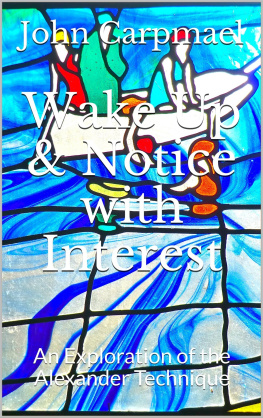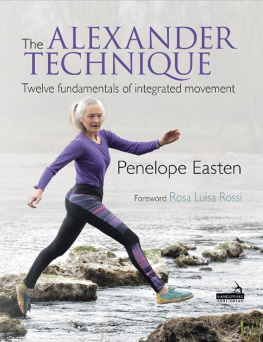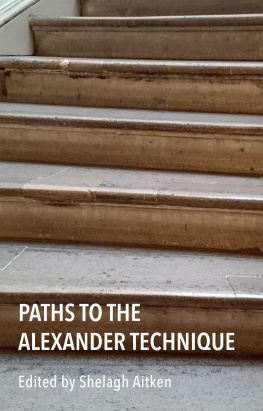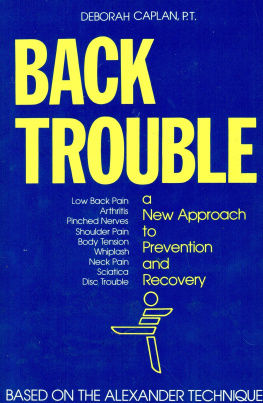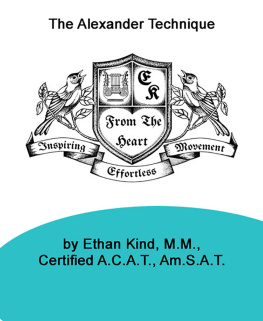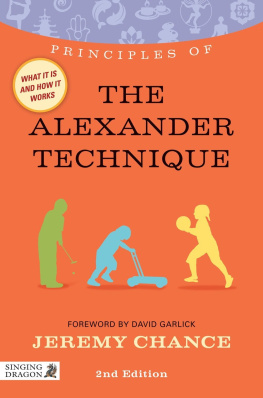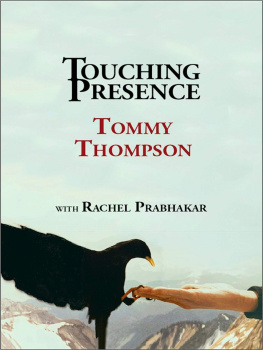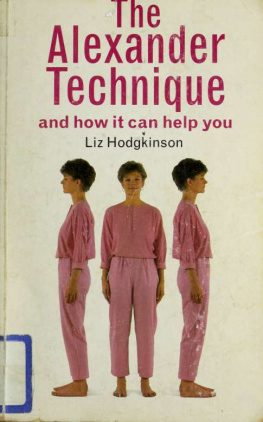Wake Up
& Notice with Interest
An Exploration of
the Alexander Technique
John Carpmael
MA(Oxon.), MBRCP, Cert. STAT, RSHom
Copyright John Ainley Carpmael 2015
All Rights Reserved
version 1.4
For my Mum
who first introduced me to the Alexander Technique
For my lovely Alexandrian wife
And for all my teachers and pupils
A very advanced craft
and a very subtle philosophy
Special thanks to my pupil Claudia Grist for her Foreword;
to everyone who has read drafts of this book
and given their comments;
to my brother Pat for his proofreading and his enthusiasm;
and to Ali and our dog, Red,
for posing in the photographs.
Contents
Foreword by Claudia Grist
Once a week I have a lesson in noticing. Sounds ridiculous, but it is interesting what it involves and where it leads.
When I arrive for my lesson, my teacher asks me how I am, what is happening in my life. We take a few minutes, which gives me a chance to unburden myself and become aware of what is happening for me.
Then we start with the standing up work: I stand in front of a chair. My teacher asks me: So, what have you been noticing?, while gently moving my limbs and joints. This happens in a variety of ways, from direct manipulation of an arm or foot, to the gentlest of touching to bring attention to a particular joint or muscle.
All the while I am describing what I have been noticing, physically, emotionally, mentally. I am practicing a way of noticing that is devoid of judgement - noticing with interest. It is very hard to do, at least for me. So I notice also how I am judging continuously good/bad everything and everybody.
At the same time the work my teacher and I are doing in the lesson begins to come to the forefront of my consciousness. While I am talking, now and again, like goldfish showing up just under the surface of a murky pond, there is a sensation that gets through. It seems to happen when I suddenly wake up in the here and now, because a movement is blocked, a limp jerks away, a habit is interrupted. My teacher's hands suggest a different way to try standing: can the hip-joints go back, could the spine lengthen, is there more movement in my elbow? He uses different levels of insistence and seems to be sensitive to what is possible today and what is not.
Before we work towards sitting, my teacher shows me myself in the mirror, standing up. I can see I am standing beautifully, straight, joint-up, tall. Some days it feels easy, others it feels difficult and full of effort. I have learnt that my habits of how I do things like standing are strong. Nevertheless, I have learnt that noticing them seems to create space for new ones. My teacher is there to suggest and practice with me. I learn when I let through what is offered.
Rather than saying from now on I will always push my hips back when I stand, which immediately leads to tensions in other parts of my body, I find myself noticing my hip-joints occasionally. For a start, I now know where they are. I always had them in the different place in my mind's eye, further out. Magically, when I am walking and I pay attention to their workings, other parts of my body seem to align themselves without effort. As soon as I try to do that it leads to the opposite.
The lesson continues with sitting down a slow, deliberate sitting down, beginning with going up. This is a frequent reminder, going up, but especially when the process is sitting down. My tendency is to have an immediate and strong commitment to the end result (sitting down) which leads to skipping vital steps in a way forcing myself down as fast as possible. My teacher has a finger at the point where my spine leads into my head, reminds me to keep going up, and mentions in turn the joints involved, hips, knees, and to let my arms dangle like a marionette. Sitting down, done consciously, seems a complicated process. I notice where I have difficulties and how they change every time. I also notice how certain difficulties have gone.
Sitting, such a simple thing. I notice I am leaning forward, pulling myself down with the muscles in my abdomen, thereby sitting on my thighs. I also seem to be maintaining a great tension in my neck and shoulders. Very complicated, very interesting. My teacher mentions my seat bones, to try out sitting on them and going up. It is good to feel my seat bones, and sitting like that makes sense. Going up is still a struggle. Going down is a strong habit. I am tall, and I like to make myself small.
My teacher continues to work with my neck, my legs, my feet. Minute adjustments and movements. Bigger movements with my arms. I continue to be surprised by my limbs, they seem to have their own opinion about what can and cannot be done. Strong opinions.
Standing up again, the whole process in reverse. I confuse going up with looking up, tilting my head backwards. Remembering my hip-joints helps here, too. Leaning forward, I can just displace the weight of my upper body until my seat-bones leave the seat and the impetus gets me upright. At least that is how it feels this time. Other days my seat-bones seem glued to the seat and they are clearly committed to staying there.
The lying-down work follows. My teacher uses a table. I used to be frightened of the lying down. I felt too vulnerable. My teacher is skilful in asking for permission, not just with words, but in the way he does the work. A lesson has a known structure, which is helpful, but the process seems iterative and open to the here and now. I feel that each little bit is my choice. I can decline a movement, a touch, or a whole part, and yet continue with the rest of the lesson. This means I lie down on the table, telling myself I can get up again straight away if it is too scary. And so on, with each part of the lying-down work. Nowadays I look forward to the lying down, I revel in the discoveries I make. It has taken a while, and occasionally the old fears resurface. This seems to happen when big, old habits are having their cloaks removed.
First, my teacher puts me into the semi-supine position. This is also the only exercise I do at home. I lie on my back, with my knees bent, my feet resting on the floor. A couple of paperbacks under my head help to keep the spine straight. My arms are either loosely spread out or bent, with the hands resting on my rib cage whatever is more comfortable in the space available.
Bit by bit, my back seems to loosen up and lie flat on the floor. At the same time, the spine lengthens until I have to move the paperbacks backwards a little. That always amazes me! This means that the spaces between the vertebrae expand and the poor squashed discs can do the same. It is a lovely feeling after the standing-up work.
My teacher again works with different parts of my body, legs and arms, head, neck, and shoulder-blades, in a sequence that seems to subtly change each time. To me it feels as if there is dance going on, with each partner at times suggesting the next move. When it is working well, it has the same quality of balance between conscious, directed movement and subconscious, easy response. Now and again though, my habits of movement and emotion are not playing the game. They insist on showing me up in ungainly jerks and downright refusals. That is how I judge what happens. My teacher insists that it is interesting to notice what my habits are. There is no right or wrong, good or bad, just a possible new way.
I often keep talking through the things going on and any emotional or practical difficulties I am encountering in my life. My habits of thinking, feeling, and acting show up clearly. They sometimes seem very well illustrated by the habits of movement revealed in the lesson. The discipline of noticing with interest applies, as does the move to inhibit, to tell the old dog Habit: Stay!. Then I can see what else there is, possibly a brand-new habit to try out, which might fit better for me. This is the cycle of change my teacher has laid out for me. I practice it every lesson, and I use it for my life.
Next page
